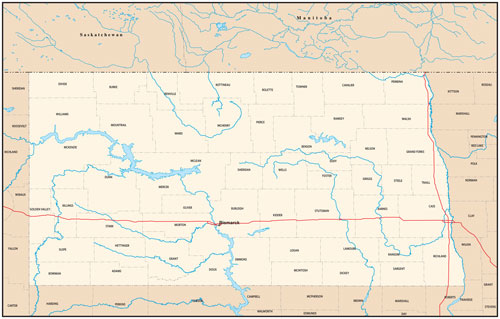Sign up for the Family Tree Newsletter Plus, you’ll receive our 10 Essential Genealogy Research Forms PDF as a special thank you!
Get Your Free Genealogy Forms
"*" indicates required fields
Teddy Roosevelt loved the state, Lawrence Welk was born here, and Lewis and Clark wintered here during their great expedition. From the plains along the Red River on its eastern border, North Dakota’s lands gradually rise to the spectacular badlands on its western border. The area’s original settlers were the Dakota (Sioux), Arapaho, Cheyenne, Mandan, Hidatsa, and Assiniboine Indians.
Fur traders from the Missouri Fur Company paved the way for settlers to come to the area. TheUnited States acquired half of the state in the Louisiana Purchase in 1803, and the other half from Britain in 1818. The first settlement was along the Red River, made by Scottish settlers from Canada on what became the Red River Ox Cart Trail. Early white settlers were primarily from Canada, states directly to the east (Minnesota, Iowa or Wisconsin), New York and Norway.
Dakota Territory was created in 1861 and included what would become North Dakota, South Dakota, Montana, and Wyoming. In 1864, Montana Territory was split off, as was Wyoming Territory in 1868.
ADVERTISEMENT
In 1871, railroads extending across Minnesota reached the Dakotas’ eastern boundary. Settlement boomed, and through 1888, large numbers of immigrants poured into the eastern part of the state. They included many Norwegians, Germans, and Germans from Russia, as well as smaller numbers of people from the British Isles and other European countries. Cycles of boom and bust, fueled partly by land speculators and partly by the inherent risks of farm yields, weather and prices, saw many settlers leave the area after a few years. The temporary successes of the Bonanza Farms, huge tracts of land owned by eastern speculators and worked by immigrant laborers, fueled some speculation. In 1889, North and South Dakota were admitted to the Union. Homesteaders again moved into the state in large numbers through 1915.
RESEARCH TIPS
ADVERTISEMENT
- The three most important repositories containing North Dakota records are the University of North Dakota in Grand Forks, North Dakota State University in Fargo, and the State Historical Society in Bismarck.
- Local county resources such as church records and newspapers are particularly important to North Dakota research, due to late settlement of the state and the relatively few record resources available. Genealogical society publications can also be helpful.
- The web can be useful for North Dakota researchers — look for links to county sources on Cyndi’s List and the North Dakota GenWeb.
CENSUS RECORDS
- Federal census: 1900, 1910, 1920
- Special census of Civil War Union veterans and widows: 1890
- State censuses: 1836 (included in the Wisconsin census), 1840 (Iowa), 1850 (Minnesota)
- Dakota territory census: 1860, 1870, 1880, 1885, 1905, 1915, 1925 (records are located at the State Historical Society of North Dakota)
- Mortality schedules: 1860, 1870, 1880, 1885
GENERAL RESOURCES
- The Black Sea Germans in the Dakotas by George Rath (Pine Hills Press, 1977)
- Chronology and Documentary Handbook of the State of North Dakota by Robert I. Vexler (Oceana Publications, 1978)
- Compendium of History and Biography of North Dakota Containing a History of North Dakota: Embracing an Account of Early Explorations, Early Settlement, Indian Occupancy . . . and a Concise History of Growth and Development of the State Also a Compendium of Biography of North Dakota (Geo. A. Ogle & Co., 1900)
- French-Canadian Families of the North Central States: A Genealogical Dictionary, 8 vols., compiled by Paul J. Lareau and Elmer Courteau (1980-1981)
- Guide to the Orin G. Libby Manuscript Collection & Related Research Collections, 3 vols., compiled by John B. Davenport, et al. (University of North Dakota, 1975-1985)
- Historical Data Project; Pioneer Biography Files (State Historical Society of North Dakota, 1988-1989)
- History of North Dakota by Elwyn B. Robinson (University of Nebraska Press, 1966)
- History of North Dakota, 3 vols., by Lewis F. Crawford (American Historical Society, 1931)
- History of the Red River Valley Past and Present, 2 vols. (Herald Printing Co., C.F. Cooper, 1909)
- North Dakota History and People, Outlines of American History, 3 vols. by C.A. Lounsberry (S.J. Clarke, 1916)
- North Dakota Research Outline by the Church of Jesus Christ of Latter-Day Saints (online at http://www.familysearch.org/eng/search/RG/guide/north_dakota.asp)
- Pioneers and Their Sons: One Hundred Sixty Five Family Histories, 2 vols. by George P. Aberle (Tumbleweed Press, 1980)
- Plains Folk: North Dakota’s Ethnic History edited by Playford V. Thorson and William C. Sherman (in cooperation with the ND Humanities Council and the University of North Dakota, 1988)
- Reference Guide to North Dakota History and North Dakota Literature compiled by Dan Rylance and J.F.S. Smeall (Chester Fritz Library, University of North Dakota, 1979)
- Steppes to Neu Odessa: Germans From Russia who Settled in Odessa Township, Dakota Territory, 1872-1876 by Cynthia Anne Frank Stupnik (Heritage Books, 2002)
- The Way it Was: The North Dakota Frontier Experience: Book Four: Germans From Russia Settlers edited by Everett C. Albers (Grass Roots Press, 1999)
Return to the main North Dakota page
From the Family Tree Sourcebook
Also available: the State Research Guide Book, State Research Guides CD and The Researcher’s Guide to American Genealogy.
ADVERTISEMENT

